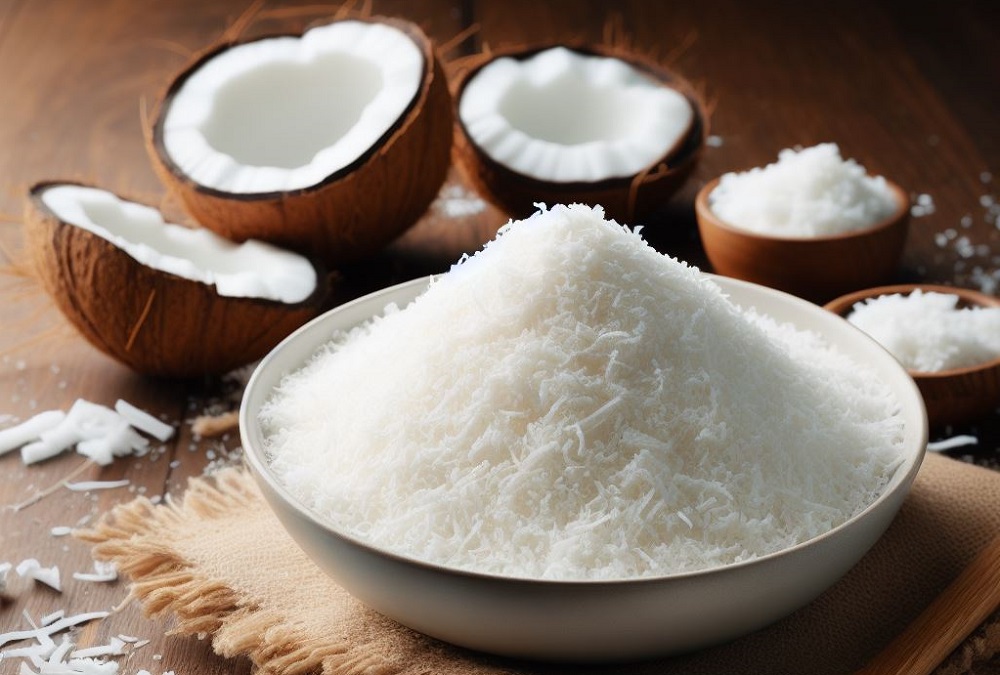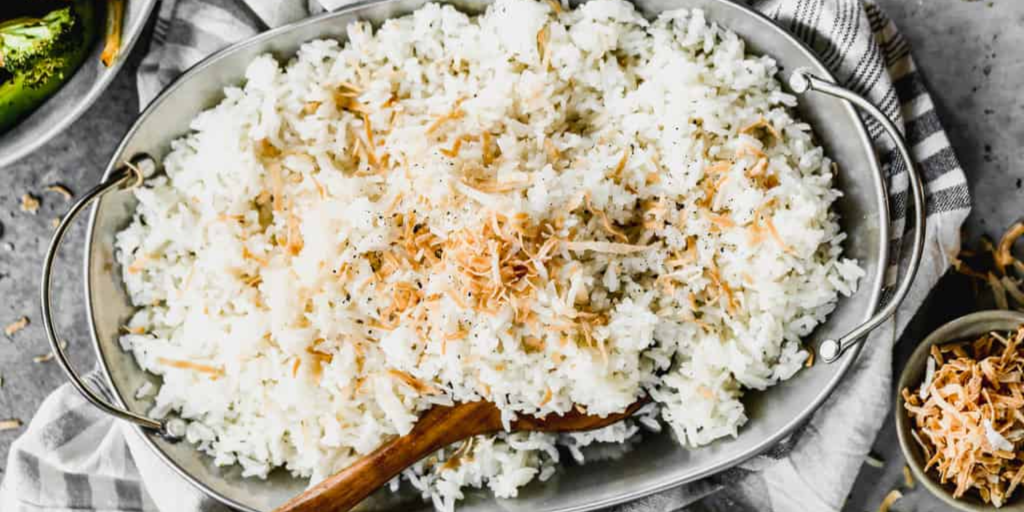Table of Contents
The Essence of Coconut Rice: A Culinary Adventure
Coconut rice is not merely a dish; it’s a culinary adventure that takes your taste buds on a journey to the tropics. This delightful dish is infused with the rich, creamy essence of coconut, creating a unique flavor profile that is both comforting and exotic. As a staple in many tropical regions, particularly in Nigeria, coconut rice holds a special place in the hearts and kitchens of many. In this comprehensive guide, we will explore how to prepare coconut rice using desiccated coconut, offering a step-by-step approach that ensures perfect results every time. Whether you’re an experienced cook or just starting out, this guide will help you master the art of making this delectable dish.
The Cultural Significance of Coconut Rice in Nigeria
In Nigeria, food is an integral part of culture and tradition. Coconut rice, with its rich flavors and aromatic qualities, is often prepared for special occasions, family gatherings, and festive celebrations. The use of coconut in Nigerian cuisine dates back centuries, reflecting the country’s abundant natural resources and culinary ingenuity. Coconut rice embodies the essence of Nigerian hospitality and the joy of sharing a delicious meal with loved ones. It is a dish that not only satisfies the palate but also brings people together.
Why Desiccated Coconut?

While fresh coconut milk is traditionally used in making coconut rice, desiccated coconut offers a convenient and equally flavorful alternative. Desiccated coconut is made by drying shredded coconut flesh, which preserves its natural sweetness and aroma. Using desiccated coconut allows you to enjoy the deliciousness of coconut rice even when fresh coconuts are not readily available. This ingredient is versatile, easy to store, and can be used in various recipes, making it a valuable addition to your pantry.
Ingredients for Coconut Rice with Desiccated Coconut
Essential Ingredients
To prepare coconut rice with desiccated coconut, you will need the following essential ingredients:
- Rice: Long-grain rice is preferred for its ability to remain fluffy and separate after cooking.
- Desiccated Coconut: The star ingredient that imparts a rich coconut flavor to the rice.
- Water: Necessary for cooking the rice and rehydrating the desiccated coconut.
- Salt: Enhances the overall flavor of the dish.
- Onion: Adds a subtle sweetness and depth to the rice.
How to prepare coconut rice step by step? Best of 2024
Optional Ingredients
For added flavor and variety, consider incorporating the following optional ingredients:
- Garlic: Provides a hint of pungency and depth.
- Ginger: Adds a warm, spicy undertone.
- Bay Leaves: Infuses the rice with a subtle herbal aroma.
- Pepper (Black or Scotch Bonnet): Adds heat and enhances the overall flavor profile.
- Vegetables: Peas, carrots, bell peppers, and green beans add color and nutrition.
- Protein: Shrimps, chicken, or fish can be incorporated for a more substantial meal.
Ingredient Preparation

Before you start cooking, it’s important to prepare your ingredients. Here’s how:
- Rice: Rinse the rice thoroughly under cold water to remove excess starch, which helps achieve a fluffy texture.
- Desiccated Coconut: Measure the required amount and set aside.
- Onion, Garlic, and Ginger: Peel and finely chop or grate.
- Vegetables: Wash, peel, and dice into small, uniform pieces.
Step-by-Step Guide to Making Coconut Rice with Desiccated Coconut
Step 1: Rehydrating the Desiccated Coconut
- Measure the Desiccated Coconut: Start by measuring out the required amount of desiccated coconut. For a rich coconut flavor, use about one cup of desiccated coconut for every two cups of rice.
- Rehydrate the Coconut: Place the desiccated coconut in a bowl and add warm water. Let it sit for about 10-15 minutes, allowing the coconut to absorb the water and rehydrate. This process will enhance the coconut’s flavor and texture.
How to Make Nigerian Yamarita: Nigerian Best 2024
Step 2: Preparing the Rice
- Rinse the Rice: Place the rice in a sieve and rinse under cold running water until the water runs clear. This removes excess starch and prevents the rice from becoming sticky.
- Soak the Rice (optional): For even cooking, you can soak the rice in cold water for about 20 minutes, then drain.
Step 3: Cooking the Aromatics
- Heat Oil: In a large pot, heat a tablespoon of oil over medium heat.
- Sauté Onions: Add the chopped onions and sauté until they become translucent and fragrant.
- Add Garlic and Ginger: If using, add the minced garlic and ginger, and sauté for another minute.
Step 4: Combining Ingredients
- Add Rice: Stir the rinsed and drained rice into the pot with the sautéed aromatics. Stir well to coat the rice with the oil and aromatics.
- Add Rehydrated Coconut and Water: Add the rehydrated coconut along with its soaking water to the pot. Top up with additional water if necessary to achieve the correct liquid-to-rice ratio (generally 2:1).
- Season: Add salt and any other seasonings you are using (e.g., bay leaves, pepper).
Step 5: Cooking the Rice
- Bring to a Boil: Increase the heat to high and bring the mixture to a rolling boil.
- Simmer: Once boiling, reduce the heat to low, cover the pot with a tight-fitting lid, and simmer for about 15-20 minutes.
- Check for Doneness: After 15 minutes, check if the rice is tender and the liquid is absorbed. If not, cover and cook for a few more minutes.
- Fluff the Rice: Once done, remove from heat and let it sit, covered, for an additional 5 minutes. Then, fluff the rice with a fork.
Step 6: Adding Vegetables and Protein (Optional)
If you are incorporating vegetables or protein:
- Cook Protein Separately: If adding chicken, shrimp, or fish, cook them separately and then add to the rice during the last 5 minutes of cooking.
- Add Vegetables: Stir in the vegetables during the last 5 minutes of cooking the rice. This ensures they remain vibrant and slightly crunchy.
Step 7: Serving the Coconut Rice
- Plate the Rice: Transfer the cooked coconut rice to a serving dish.
- Garnish: Garnish with fresh herbs like cilantro or parsley for added color and flavor.
- Serve: Serve hot, accompanied by your favorite side dishes or on its own.
Classic Spaghetti with Bolognese Sauce Recipe Best 1
Tips and Tricks for Perfect Coconut Rice with Desiccated Coconut

Choosing the Right Rice
The type of rice you choose can significantly impact the final dish. Long-grain rice, such as basmati or jasmine, is ideal for coconut rice due to its ability to stay fluffy and separate after cooking. Short-grain rice tends to be stickier and might not provide the desired texture.
Balancing the Coconut Flavor
The key to perfect coconut rice is balancing the coconut with water. Using too much coconut can make the rice overly rich and greasy, while too little can result in a lack of flavor. A 1:1 ratio of rehydrated coconut (including its soaking water) to additional water is usually a good starting point, but feel free to adjust based on your taste preferences.
Enhancing the Flavor
To enhance the flavor of your coconut rice, consider incorporating additional aromatics and seasonings. Garlic, ginger, and bay leaves add depth and complexity, while a touch of pepper can introduce a pleasant heat. Additionally, toasting the rice slightly in oil before adding the liquid can bring out a nutty aroma.
Cooking Techniques
Maintaining the right temperature and cooking time is crucial for achieving perfectly cooked coconut rice. Bringing the mixture to a boil before simmering ensures that the rice cooks evenly. Keeping the pot covered during cooking helps to trap steam and moisture, resulting in fluffy rice. Avoid stirring the rice during cooking, as this can cause it to become mushy.
Variations of Coconut Rice with Desiccated Coconut

Nigerian Coconut Jollof Rice
One popular variation in Nigeria is Coconut Jollof Rice, which combines the rich flavors of coconut rice with the vibrant and spicy notes of traditional Jollof rice. To make Coconut Jollof Rice, you will need:
- Rice
- Desiccated coconut
- Tomato paste
- Onions
- Garlic
- Ginger
- Scotch bonnet pepper
- Bell peppers
- Mixed vegetables
- Chicken or fish (optional)
The preparation involves cooking the rice with rehydrated desiccated coconut and a tomato-based sauce, resulting in a colorful and flavorful dish that is often served at parties and special occasions.
Thai Coconut Rice
In Thai cuisine, coconut rice is often prepared with jasmine rice, desiccated coconut, sugar, and salt. It is commonly served with savory dishes like Thai curries or grilled meats. The addition of sugar gives it a slightly sweet taste, making it a perfect complement to spicy and savory foods.
Caribbean Coconut Rice and Peas
Caribbean Coconut Rice and Peas is another delicious variation, incorporating kidney beans or pigeon peas, desiccated coconut, and aromatic spices like thyme and allspice. This dish is a staple in Caribbean households and is often served with jerk chicken or grilled fish.
How to Make Efik fisherman soup. Nigerian Best 2024
Serving Suggestions for Coconut Rice with Desiccated Coconut
Pairing with Main Dishes
Coconut rice is versatile and pairs well with a variety of main dishes. Some popular pairings include:
- Grilled or Fried Fish: The light and flaky texture of fish complements the creamy coconut rice perfectly.
- Chicken Stew: A hearty chicken stew with rich, flavorful gravy is an excellent accompaniment.
- Vegetable Curry: For a vegetarian option, pair coconut rice with a spicy vegetable curry.
- Shrimp Skewers: Grilled shrimp skewers add a delightful seafood touch to the meal.
Side Dishes and Garnishes
To complete your meal, consider serving coconut rice with a variety of side dishes and garnishes:
- Plantains: Fried or baked plantains add a sweet and savory element to the meal.
- Salad: A fresh, crisp salad with a light vinaigrette balances the richness of the rice.
- Pineapple Salsa: The tangy sweetness of pineapple salsa enhances the tropical flavors of coconut rice.
- Roasted Vegetables: Roasted vegetables like bell peppers, zucchini, and carrots provide a colorful and nutritious side.
Beverage Pairings
Complement your coconut rice meal with refreshing beverages such as:
- Coconut Water: Enhances the coconut flavor and provides a hydrating drink option.
- Mango Smoothie: The sweetness of mango pairs well with the savory rice.
- Tropical Punch: A blend of pineapple, orange, and passion fruit juices creates a refreshing drink that complements the meal.
Health Benefits of Coconut Rice with Desiccated Coconut

Nutritional Value
Coconut rice is not only delicious but also packed with nutrients. Here are some of the health benefits:
- Vitamins and Minerals: Desiccated coconut is rich in vitamins C, E, B1, B3, B5, and B6, as well as iron, selenium, sodium, calcium, magnesium, and phosphorus.
- Healthy Fats: Desiccated coconut contains medium-chain triglycerides (MCTs), which are a type of healthy fat that can provide a quick source of energy.
- Antioxidants: Coconut has antioxidant properties that help fight free radicals in the body.
- Fiber: Rice and desiccated coconut provide dietary fiber, which aids in digestion and promotes a healthy gut.
Gluten-Free Option
Coconut rice is naturally gluten-free, making it an excellent choice for those with gluten intolerance or celiac disease. By ensuring that all ingredients are gluten-free, you can enjoy this dish without any concerns.
Energy Boost
The combination of rice and desiccated coconut provides a good source of carbohydrates and fats, making coconut rice an energy-boosting meal. This is particularly beneficial for athletes or individuals with high energy demands.
Troubleshooting Common Issues
Rice Too Sticky
If your coconut rice turns out too sticky, it may be due to using the wrong type of rice or not rinsing the rice thoroughly before cooking. To avoid this, use long-grain rice and rinse it well to remove excess starch.
Rice Undercooked
Undercooked rice can be a result of insufficient liquid or cooking time. Ensure you use the correct ratio of liquid to rice and cook it for the recommended time. If needed, add a little more water and continue cooking until the rice is tender.
Rice Overcooked
Overcooked rice can become mushy and unappetizing. To prevent this, avoid over-stirring the rice during cooking and use a tight-fitting lid to trap steam and cook the rice evenly.
Storing and Reheating Coconut Rice with Desiccated Coconut
Storing Leftovers
To store leftover coconut rice, allow it to cool completely before transferring it to an airtight container. Store in the refrigerator for up to 3-4 days.
Reheating
To reheat coconut rice, you can use a microwave or stovetop method:
- Microwave: Place the rice in a microwave-safe dish and sprinkle a few drops of water over it. Cover with a microwave-safe lid or plastic wrap and heat for 1-2 minutes or until heated through.
- Stovetop: Place the rice in a saucepan and add a splash of water or coconut milk. Cover and heat over low heat, stirring occasionally, until warmed through.
Freezing
For longer storage, coconut rice can be frozen. Place cooled rice in a freezer-safe container or zip-lock bag, removing as much air as possible. Freeze for up to 2 months. To reheat, thaw in the refrigerator overnight and follow the reheating instructions above.
Conclusion
The Joy of Cooking Coconut Rice with Desiccated Coconut
Coconut rice with desiccated coconut is a dish that combines convenience with the rich, tropical flavors of coconut. It offers a taste of the tropics in every bite, making it a favorite in many households. Its creamy texture, aromatic scent, and versatility make it a dish that can be enjoyed in various forms, from traditional Nigerian meals to international cuisines.
Embracing Variations and Creativity
One of the joys of cooking coconut rice is the opportunity to experiment with different variations and flavors. From the traditional Nigerian Coconut Jollof Rice to Thai and Caribbean versions, there is no limit to the creativity you can bring to this dish. Feel free to customize your coconut rice with different vegetables, proteins, and spices to suit your taste preferences.
A Dish to Share and Celebrate
Coconut rice is a dish that brings people together, whether it’s for a festive celebration, a family dinner, or a casual meal with friends. Its comforting flavors and rich history make it a dish worth sharing and celebrating. So, gather your loved ones, prepare a pot of delicious coconut rice with desiccated coconut, and enjoy the wonderful flavors and memories it brings.





















